The Meelfabriek is a place with an eye for the past, present ánd the future, thanks to the great attention for sustainability measures. A great diversity is interwoven throughout the project. Both in and on the buildings, at ground level and underground.
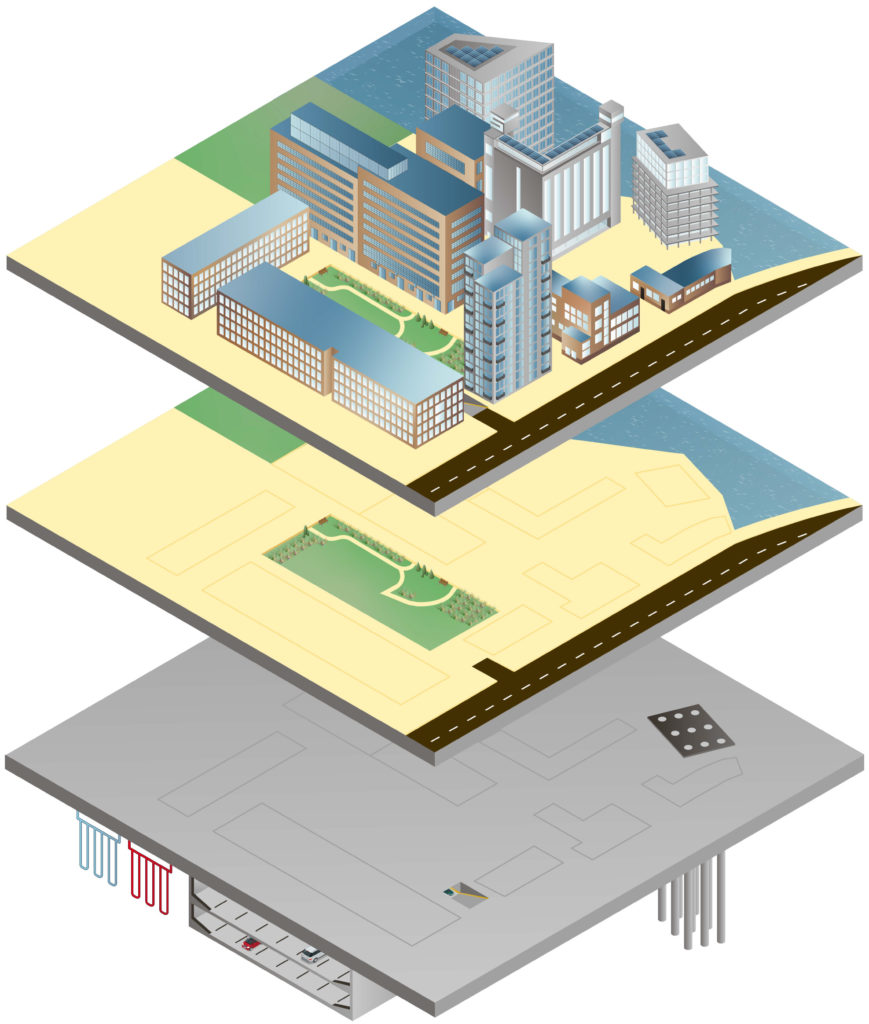

The re-use of the National Monuments means that many parts of the buildings, such as the bricks, foundations, concrete floors and roofs, steel facade frames and other materials do not have to be produced, transported and processed again. This saves supply, transport and production, and therefore a lot of energy and raw materials. The complex of De Meelfabriek consists of 8 national monuments. For each building, a search was made for what can be effectively reused.
WHERE
- Riffellokaal
- Directiekantoor
- Poortgebouw
- Silogebouw
- Schoonmakerij
- Ketelhuis
- Meelpakhuis

Materials and/or parts of the buildings will be retained or reused as much as possible. This can vary from re-use of the entire shell to piles and heavy foundations that are already in the ground and on which a new building is built.
In this way, all the load-bearing hulls of Molengebouw, Riffellokaal, Silogebouw, Meelpakhuis, Schoonmakerrij and Ketelhuis will remain intact and be reused for the new purpose. In addition, the foundations and pile constructions of Silo D and Silo C will largely be preserved in order to later erect new buildings such as the Silotoren and the stairwell with lifts of the hotel.
The original steel window frames in the monumental buildings are almost all restored and reused and fitted with high quality insulating glazing. The wooden ceilings in the Molengebouw and Riffellokaal have mostly been restored and almost all of the original doors, floors and interior elements of the Directiekantoor and the Poortgebouw have been restored to their original state and will last for years. Sometimes parts are used in other places or to repair or replace disappeared parts after 30 years of vacancy.
Where possible, materials are recycled. For example, where constructively possible, concrete is partly made from concrete rubble from buildings that have been demolished elsewhere. In addition, all construction and demolition waste from the Meelfabriek is separated by type, after which it is deposited with the processor for maximum reuse. This leaves as little worthless residual material as possible.
WHERE
- Riffellokaal
- Silogebouw
- Schoonmakerij
- Ketelhuis
- Meelpakhuis
- Silotoren

By keeping the development of the design, the technical elaboration, realization and sale in one hand, it is possible to deliver custom-made products to buyers. In this way, buyers of apartments are given maximum freedom to choose the layout and finishing according to their wishes. In the Molengebouw and Riffellokaal, for example, not a single loft has the same layout, which means that you create an apartment where people do not need to rebuild after completion, which in turn saves material and waste.
WHERE
- Riffellokaal
- Meelpakhuis
- Silotoren
- Singeltoren

In order to reduce the number of cars at ground level, a 3-storey underground car park will be built which will provide space for more than 300 cars for visitors, residents and employees of offices, shops, hotel and Spa and Wellness. As a result, the site can offer space for De Meelfabriek Garden and fits in nicely with the Singelpark.
WHERE
- Meelfabriek Tuin
- Meelfabriek Plein
At the Meelpakhuis and the Silotoren we choose the best option in terms of glass insulation, this is called triple glazing or HR+++ glass. But also in the other buildings at least HR++ double glazing is used. For the national monuments we are looking to improve the insulation, within the possibilities of the existing window frames. Here we apply a very thin variant with Argongas as insulator, this is a considerable improvement compared to ordinary double glazing and certainly compared to the original single glazing and leaves the details of yesteryear intact.
Good glass insulation prevents draughts and cold at the windows, condensation on the inside of the window and you hear much less noise from outside. By insulating the temperature from outside to inside, but also vice versa, you save energy.
WHERE
- Molengebouw
- Riffellokaal
- Directiekantoor
- Poortgebouw
- Silogebouw
- Schoonmakerij
- Ketelhuis
- Singeltoren
- DUWO-gebouw
Driedubbel glas:
- Silotoren
- Meelpakhuis
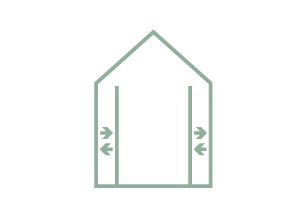
Insulating the exterior walls actually means adding an extra layer to the original facade, which reduces heat loss on cold days and keeps the heat out better on hot days. In the case of the national monuments, particular attention is paid to the original and new moisture management in order to prevent it from becoming dampened in the structures as a result of good insulation, which could lead to moulds. Sometimes insulation is provided on the outside and sometimes on the inside. The entire concrete Silo building is insulated on the outside and so the past remains visible on the inside of the hotel rooms. However, most buildings are insulated on the inside so as not to affect the characteristic facades.
WHERE
- Riffellokaal
- Directiekantoor
- Poortgebouw
- Silogebouw
- Schoonmakerij
- Ketelhuis

Old buildings can lose a lot of heat through a roof and on sunny days too much heat can come in. We searched for the best way for each building and that means that most buildings on top of the existing roof are provided with a substantial package of insulation. Only the round roof of the Ketelhuis is insulated on the inside to keep the special shape and the connection of the roof to the facades intact. Because of good insulation, less heat is lost and less cooling is needed, which results in less energy consumption.
WHERE
- Riffellokaal
- Directiekantoo
- Poortgebouw
- Silogebouw
- Schoonmakerij
- Ketelhuis
- Meelpakhuis
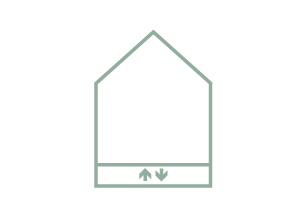
Lovely warm feet and lower energy costs, that’s the result of good floor insulation. For new buildings this goes without saying, but for old buildings it is a matter of finding the best way to achieve this. Yet at De Meelfabriek we ensure that this is optimal in every building.
In Molengebouw, Riffellokaal and Meelpakhuis, for example, the floors are raised slightly. All the pipes are pulled through this layer, so that the original ceiling of the layer underneath can also be preserved for the optimal monumental character. This thick layer has an insulating effect and also contains underfloor heating and cooling, which are fed by the hot and cold sources. Here, too, less heat is lost through insulation, but above all, the insulation provides extra comfort.
Waar
- Riffellokaal
- Directiekantoor
- Poortgebouw
- Silogebouw
- Schoonmakerij
- Ketelhuis
- Meelpakhuis
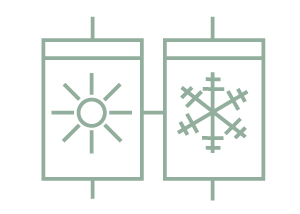
For a large part of the buildings at De Meelfabriek, the necessary heat or cold is extracted from the earth in the summer. For this purpose, we have constructed fields with closed loops that sometimes go as deep as 200 metres into the ground. A fluid is pumped through the pipeline that heats up in the process to the depth and up again by a few degrees. If you now do this continuously and use that few degrees difference over and over again, you can then make water of 40 to 50 degrees. With this you can easily feed the underfloor heating. In the summer you do it the other way around. The warmth that is in the underfloor heating hoses is transported down into the colder earth and you get cooled water back up. That cold energy you give off to the floor and then the house cools down wonderfully. This also contributes greatly to lower energy costs but of course also to comfort.
WHERE
- Riffellokaal
- Directiekantoor
- Meelpakhuis
- Singeltoren
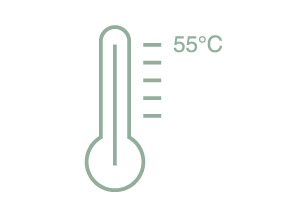
Most buildings in the Netherlands still have a central heating boiler and radiators. The boiler heats the water that goes to the radiators to about 70 to 80 degrees. In buildings that are not so well insulated, that high water temperature is needed to get the building warm on cold days. A well-insulated building (like all De Meelfabriek buildings) can also be heated with a water temperature of about 35 to 55 degrees: this is the temperature provided by a heat pump or a ground source heat system. The only requirement is that the heating system is able to give off sufficient heat: this requires a large surface area of the source of emission. Underfloor heating is ideal for this, which is why all homes at De Meelfabriek are fitted with this as standard. Where this method is not (entirely) possible – such as in the restored Directiekantoor – special radiators are installed that are suitable for low-temperature heating.
WHERE
- Riffellokaal
- Directiekantoor
- Poortgebouw
- Silogebouw
- Schoonmakerij
- Ketelhuis
- Meelpakhuis
- Silotoren
- Singeltoren

Both in the buildings and on the grounds, the choice was made to carry out all lighting in LED, which consumes considerably less energy than traditional halogen and fluorescent lighting. In the garage, the lighting is also switched according to requirements and use, which in turn saves a lot of energy.
WHERE
- Riffellokaal
- Directiekantoor
- Poortgebouw
- Silogebouw
- Schoonmakerij
- Ketelhuis
- Meelpakhuis
- Silotoren
- Singeltoren
- DUWO-gebouw
- Parkeergarage
- Meelfabriek Tuin
- Meelfabriek Plein

Monitoring energy consumption can stimulate awareness. The effects of energy-efficient choices become more apparent and work as an incentive for users to activate sustainable measures.
WHERE
- Riffellokaal
- Directiekantoor
- Silogebouw
- Schoonmakerij
- Ketelhuis
- Meelpakhuis
- Silotoren
- Singeltoren
- Parkeergarage

Solar panels convert the sun’s energy into electricity. The French physicist Becquerel discovered this as early as 1839. Nowadays, this sustainable energy source is used more and more. To generate electricity, solar panels do not necessarily need direct sunlight. Even on a cloudy day, a solar cell supplies electricity. However, the yield is optimised by as much sun as possible, which is why the right position is important. However, the choice of positioning is limited in the case of a national monument. The appearance of the buildings must not be disturbed by the panels, so installation is not always possible. Where possible, they are applied.
WHERE
- Ketelhuis
- Silotoren
- Silogebouw
- Meelpakhuis

Sometimes energy savings can be achieved simply by reducing the cooling requirement. Sun blinds make a very functional contribution to this. This ensures a pleasant indoor climate in the summer. In winter it can also influence the indoor climate by using the sun blinds as a heat buffer.
WHERE
- Molengebouw/Riffellokaal
- Meelpakhuis
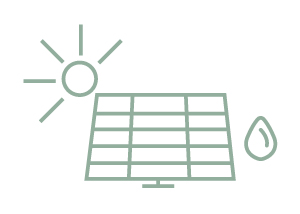
Solar collectors on the roof capture the sunlight and use its energy to supply hot water through a solar boiler in the house. With such a solar boiler you use about half the energy for hot water. This makes it an environmentally friendly alternative to natural gas, because no CO2 is released when solar energy is used. In a period with less sunlight, this is replenished by hot water using the heat pump technology or thermal sources.
WHERE
- Ketelhuis
- Silotoren
- Silogebouw
- Meelpakhuis
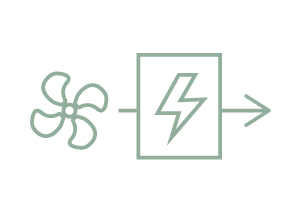
Special ventilation units not only ensure the supply of fresh air and the removal of polluted air, but also heat regulation. If the incoming air already heats up with the warmth of the outgoing air, you achieve optimum energy savings and a comfortable effect.
WHERE
- Riffellokaal
- Directiekantoor
- Poortgebouw
- Silogebouw
- Schoonmakerij
- Ketelhuis
- Meelpakhuis

Sometimes soil sources are not possible due to space requirements, in which case heat pump technology is used that extracts energy from the outside air and releases it to water. In this way, the heat pumps can turn low-grade energy into warm water of 40 to 50 degrees, which can be used for underfloor heating. In the summer you can also generate cold water to chill the floor. The energy efficiency of heat pumps has improved enormously in recent years and they are a factor of 5 more economical than a traditional central heating boiler. This also contributes enormously to lower energy costs and, of course, comfort.
WHERE
- Ketelhuis
- Silotoren
- Silogebouw

To regenerate ground source heat and to cool down the roof of the penthouse, so-called heat roof will be constructed. Imagine this as underfloor heating in the roof. The sun shines on it and heats the water in the hoses, the hoses drain the water and so the roof is cooled and the energy in the hot water is used to heat the ground again during winter days.
WHERE
- Riffellokaal

We strive to minimize the use of energy through energy efficient solutions and minimizing loss. The energy we do need, we from our own sustainable sources. However, our own yield is not entirely sufficient. This is partly due to the limited possibilities of installing solar panels and collectors on national monuments. The energy we still have to purchase is collected from a supplier who also generates it 100% sustainably, for example from wind or solar parks.
WHERE
- Riffellokaal
- Directiekantoor
- Poortgebouw
- Silogebouw
- Schoonmakerij
- Ketelhuis
- Meelpakhuis
- Silotoren
- Singeltoren
- DUWO-gebouw
Parkeergarage
Meelfabriek Tuin
Meelfabriek Plein

Due to climate change, we are heading towards a future with periods of increased flooding and drought. At De Meelfabriek, we are aware of this and have prepared accordingly. The roof of the parking garage is equipped with a water retention system. Beneath the entire garden and surrounding areas lies a layer of crates where all rainwater is stored. Like a giant rain barrel, this water is preserved to support the plants during drier times.
In these crates, a special granulate mix of tree sand, nutrients, and lava stones is placed on stone wool. This allows water to rise from the buffer crates to the upper layers of the soil, ensuring the entire garden receives enough water to grow and flourish. The crate system is replenished not only by rainwater in the garden but also by that from the surrounding buildings. In times of excess water, overflow is directed into the Singel canal, while in dry times, the garden can draw from this buffer. A sustainable system.
Waar

In the underground car park facilities have been created for a large number of charging stations for both visitors and residents. Residents can indicate directly when purchasing their parking space that they would like to have an electricity supply. But they can also opt for this at a later stage. Thanks to the preparations in the work with empty pipes, this will be easier to realize and will make the transition more accessible.
In addition, the future energy demand in the garage will be taken into account by building in a system for even distribution. And of course, the energy supplied is always 100% sustainable
WHERE

As an alternative means of transport, an electric boat is available at De Meelfabriek. Currently available to charter for parties, but plans are being developed to use electric transport over water more regularly for visitors to De Meelfabriek.
WHERE

About 95 percent of all homes use natural gas for heating, hot water and cooking. The government wants all homes to be off natural gas by 2050. The Meelfabriek anticipates this by not only constructing the new buildings without natural gas, but also providing all national monuments with alternative energy. The alternative to fossil natural gas is sustainable energy. Electric heating is only a sustainable alternative to fossil natural gas if the electricity is also generated sustainable. De Meelfabriek is responsible for this through various measures. If we simply replace gas with electricity, this will lead to an enormous demand for electricity. That is why we are also making sure that the buildings are heated efficiently with less electricity.
WHERE
- Riffellokaal
- Directiekantoor
- Poortgebouw
-Silogebouw
- Schoonmakerij
- Ketelhuis
- Meelpakhuis
- Silotoren-Singeltoren

Already there are bikes for rent for entrepreneurs who need to go into town and tourists who want to discover the area. With the expected guests of the hotel in combination with the pleasant location of De Meelfabriek, this demand will only increase. This healthy, convenient and sustainable means of transport will therefore be abundantly available.
WHERE

Sustainability also translates into the conceptual interpretation for De Meelfabriek. Entrepreneurs with a sustainable philosophy have an advantage and it is with good reason that these companies feel at home here. A vegan lunchroom, rental company of electric transport, but also a sewing atelier as a counterpart of the cheap fast-fashion industry and other creative and innovative companies are already established on the site. In addition, we are convinced that the development of body and mind contributes to a sustainable lifestyle, therefore there will be plenty of space for sports, wellness, art and culture.

